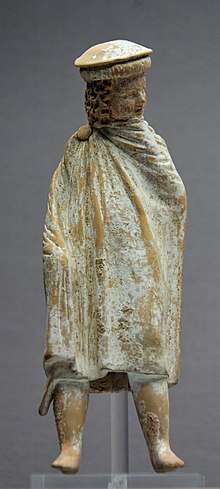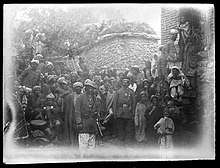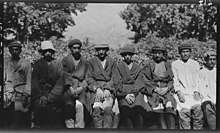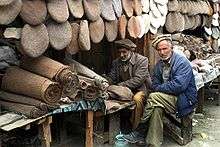Pakol
Pakol (Khowar: پکول Pashto: پکول; Persian: پکول; Balti بروقپی نتینگ; Tajik: Паколь; Shina/Khowar language: Pakhui; Wakhi Seeked/Brushashki: Phartsun),[1][2] in Afghanistan also known as the Chitrali cap,[3] is a soft round-topped men's hat, typically of wool and found in any of a variety of earthy colors: brown, black, grey, ivory or dyed red using walnut. Pakol is a Khowar Chitrali word and is derived from the word Khoi which means hat in Khowar. Another Khowar name for the hat is Khapol.[4] The cap's origin are debated upon with a theory of a possible origin in southeastern Europe, however the general consensus among historians and ethnographers is for it to have originated from Chitral, which was at the time part of Nuristan, an Afghan province.[5][6][7] The woolen cap has been the staple headgear of the Chitrali people for centuries.[8][9] The main source of production is Chitral in Pakistan which is also located at the center of its range.[10] It is also worn in Gilgit-Baltistan, Dir in Pakistan and also by Afghans such as the Pashtuns, Tajiks and Nuristani people. Nuristan is a major region where it is imported from Chitral.[11]
_(14779945541).jpg)
Overview
The pakol gained popularity in Nuristan in Afghanistan after the campaign of Emir Abdul Rehman.[12] It's also worn in Chitral, Swat and Dir in Pakistan and is a considered a staple of their ethnic background. In the past couple decades, the pakol has also been worn in India, especially in parts of Delhi and Jammu & Kashmir.[13][14]
Origins and History

Kausia and Alexander
The pakol is remarkably similar to the ancient Macedonian kausia hat, worn by men in ancient Southeast Europe, which may have been its ancestor.[15][16] According to Bonnie Kingsley the kausia may have came to the Mediterranean as a campaign hat worn by Alexander and veterans of his campaigns in India.[17] but according to Ernst Fredricksmeyer the kausia was too established a staple of the Macedonian wardrobe for it to have been imported from Asia to Macedonia.[18]
Criticism of Macedonian Link

However Willem Vogelsang of the National Museum of Ethnology in Leiden, showed that the pakool is actually a simple adaptation of caps with rolled rims worn all over the borderlands of China, India and Central Asia.[19] At the juncture of the 3 regions lies Chitral forming a watershed.[20]
_(14596455118).jpg)
Origin, Discovery and Documentation in Chitral
The modern Pakol is believed to have originated from the Chitral then part of Khorasan now after 1947 became region of Pakistan where it was made and found exclusively until the end of the 19th century.[6][21] The word Pakol is a chitrali word derived from another chitrali name of the hat Khapol. The Pakol is made from a special type of wool known as the Chitrali patti which is procured from the sheepherders from its valleys. The earliest mention of the Pakol is attributed to Donatus O'Briens' book (1895) on the language of Chitral, where describing the ethnic dress of Chitralis he states that:
"The dress worn by most men consist of a homespun cap black, brown or grey made in the shape of a bag and rolled up until it fits the skull."[22]
Later on in 1896 George Scott Robertson denoted the cap with the name "Chitrali Cap".[23]

Early mentions of its nativity and homogeneity to Chitral and its English and local nomenclature paired with documentation of it not being worn in any of the regions surrounding Chitral make it evident that the Pakol most probably originated from the Chitral region of Northern Pakistan where it was worn exclusively till the end of the 19th century.
The Kafiristan Campaign and Adoption by Nuristanis

The earliest documentations of the inhabitants of Kafiristan states that they went about without any headgear.[23] Another source refers to the pakol as the chitrali cap and states that it is only worn in the Bashgul valley as an imported article of clothing because of Bashgul's proximity to Chitral.[24]
Pakols must have spread at a quick pace among the locals, now renamed Nuristanis, after and partially as a consequence of the conquest of Kafiristan by Abdul Rahman Khan of Afghanistan. The opening up of the valleys to increased contact and trade, and the population's conversion to Islam, might have provided incentives for the residents to abandon their previously distinctive hairstyle and cover their heads with hats. It seems logical that the men adopted one with which they were already acquainted, and that was readily available locally. The adoption of specific items of clothing to mark a new identity, especially a religious one, is well-established in history.[25]
Initial Prominence in Pakistan
The Pakol first found for itself prominence in Pakistan by Chitrali traders and businessmen who expanded their businesses.[26] The Pakol was started to be worn in many parts of Pakistan especially the adjoining areas to Chitral such as Dir, Swat, Malakand and Bajaur.
Initial Prominence in Afghanistan
In the 1980s, the pakol was worn by a special unit of the Afghan Mujahideen who fought against the Soviets. The pakol owes its global celebrity to the Tajik-majority members of the Jamiat-e Islami Afghanistan, who, following their leader Ahmad Shah Massoud, first adopted it as a standard item of their outfit. Since then the headware has become famous in Afghanistan.
See also
References
- Mir, Ziab R (1 October 2016). "My Cap, My Identity: Men's caps from Gilgit-Baltistan". Pamir Times.
- Blackwood, William (1968). "Blackwood's Magazine". Vol. 303. Cite magazine requires
|magazine=(help) - Chohan, Amar Singh (2014-07-14). A History of Kafferistan: Socio-economic and Political Conditions of the Kaffers.
- Condra, Jill (2013-04-09). Encyclopedia of National Dress: Traditional Clothing around the World [2 volumes]. ABC-CLIO. ISBN 978-0-313-37637-5.
- "From Alexander the Great to Ahmad Shah Massoud: A Social History of the Pakol | Afghanistan Analysts Network". Retrieved 2020-02-20.
- Soldier of Fortune. Omega Group, Limited. 2000.
- Chico, Beverly (2013-10-03). Hats and Headwear around the World: A Cultural Encyclopedia: A Cultural Encyclopedia. ABC-CLIO. ISBN 978-1-61069-063-8.
- Organisation (Pakistan), Population Census (1999). 1998 District Census Report of [name of District].: Chitral. Population Census Organisation, Statistics Division, Govt. of Pakistan.
- Swift, Hugh (1990). Trekking in Pakistan and India. Sierra Club Books. ISBN 978-0-87156-662-1.
pakol tudor styled.
- Pushtun clothes choice-cold-nights/ "Pakol cap of Chitral" Check
|url=value (help). - Dupree, Louis (2014-07-14). Afghanistan. Princeton University Press. ISBN 978-1-4008-5891-0.
- "From Alexander the Great to Ahmad Shah Massoud: A Social History of the Pakol | Afghanistan Analysts Network". Retrieved 2020-02-24.
- Saxena, Shivam (4 March 2015). "Inside Delhi's lil Afghanistan: Aroma of Kabuli pulao, murmurs in Dari". Hindustan Times. Retrieved 16 March 2018.
Several shops run by Afghani refugees at Sharif Manzil now have flourishing businesses of imported carpets, pakol and karakuli caps (below), shawls and vasket (jackets). “We import these caps from Kabul. They are now becoming popular in India too,” says Sikander Khan, who runs a small garment shop in the area.
- "And Thugs Met Nemesis". Greater Kashmir. 22 October 2016. Retrieved 16 March 2018.
On my way for tuition to the Unique Academy at Zaina Kadal, one of the busiest marketplaces crowded with Tonga, I often spotted a couple of these known political goons sitting on a shopfront or the backseat of a Tonga puffing cigarettes cascading air around with cannabis aroma. One of them a hefty chariot driver donned in what has now been popularised by Bollywood films as ‘Pathani Suit’, ivory coloured ‘Pakol cap’, and golden thread Peshawari chappal known for his thoul (head fight) was evil personified.
- Worthington, Ian, ed. (1994). Ventures into Greek History. Clarendon Press. p. 135. ISBN 019814928X.
- Liddell, Henry George; Scott, Robert; Jones, Henry Stuart (1940). "καυσία". A Greek–English Lexicon. Clarendon Press.
- Kingsley, Bonnie M (1981). "The Cap That Survived Alexander". American Journal of Archaeology. 85: 39. doi:10.2307/504964. JSTOR 504964.
- Fredricksmeyer, Ernst (1986). "Alexander the Great and the Macedonian kausia". Transactions and Proceedings of the American Philological Association. 116: 215–227. doi:10.2307/283917. JSTOR 283917.
- "Did Alexander wear my hat?". Lugubelinus. 2016-06-04. Retrieved 2020-02-20.
- Journal of the Society of Arts. The Society. 1874.
- Chico, Beverly (2013-10-03). Hats and Headwear around the World: A Cultural Encyclopedia: A Cultural Encyclopedia. ABC-CLIO. ISBN 978-1-61069-063-8.
- "Grammar and vocabulary of the K̲h̲owâr dialect (Chitrâli)". digital.soas.ac.uk. Retrieved 2020-02-24.
- Robertson, Sir George Scott (1896). The Káfirs of the Hindu-Kush. Lawrence & Bullen, Limited. p. 515.
chitrali cap.
- Chohan, Amar Singh (1989). A History of Kafferistan: Socio-economic and Political Conditions of the Kaffers. Atlantic Publishers & Distri.
- "From Alexander the Great to Ahmad Shah Massud: A social history of the pakol". English (in Pashto). 2014-01-03. Retrieved 2020-02-29.
- Ferrari, Fabrizio (2011-03-07). Health and Religious Rituals in South Asia: Disease, Possession and Healing. Taylor & Francis. ISBN 978-1-136-84629-8.
External links
- Willem Vogelsang, 'The Pakol: A distinctive, but apparently not so very old headgear from the Indo-Iranian borderlands'. Khil`a. Journal for Dress and Textiles of the Islamic World, Vol. 2, 2006, pp. 149–155.
| Wikimedia Commons has media related to Pakol. |